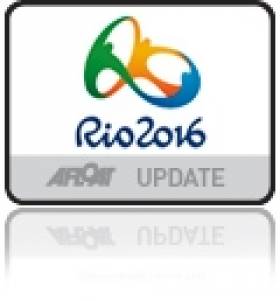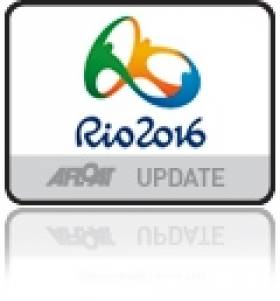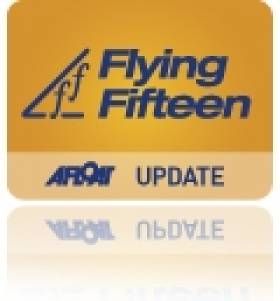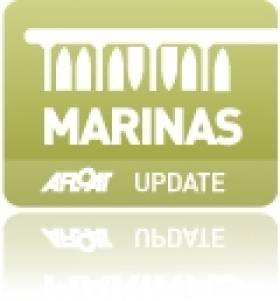Displaying items by tag: National Yacht Club
#laser– Of the 324 sailors from 43 different countries who are primed and ready to start the Laser European and World Championships on Sunday, very few took the opportunity to participate in today's official practice race on Dublin Bay.
Final boat preparations in the boat parks of Dun Laoghaire's National Yacht Club and the Royal St George Yacht Club and preserving energies proved to be the main priorities as the sailors count down to the first start guns for the three different championships which will run on two race areas.
Three European titles are on offer in two Olympic singlehanded classes, for Men in the Laser Standard, and for women in the Laser Radial. Males will also compete for the Men's World and the Men's European titles in the Laser Radial class. Racing starts Sunday and finishes Friday at Ireland's only major Olympic classes championships in the lead up to the 2016 Olympic Games in Rio. Many overseas in the Men's Olympic singlehanded fleet see this as an important build up to the Laser World Championships which are taking place in Oman in November.
The event is set to be officially opened this evening by An Cathaoirleach Cllr. Carrie Smyth, Dun Laoghaire Rathdown County Council and by An Tanaiste Eamon Gilmore at Dun Laoghaire Town Hall. This opening ceremony is to be preceded by a parade led by Irish Army No 1 Band with local junior sailors carrying the flags of all 43 nations participating in the championship.
Commenting on the importance of the globally watched event Margaret Kneafsey, Event Chairman stated "We are delighted to welcome sailors from over 43 countries to the Laser European and World Championships. Many of the sailors visited Dun Laoghaire earlier this year to practice at the venue and some of the teams arrived earlier in August to train. In addition these 320 or so sailors have also brought their coaches, their families, friends and supporters to Ireland which will have a great economic impact on Dun Laoghaire town".
For Ireland's Annalise Murphy the Laser Radial Women's European Championship represents a great opportunity to win a major title on her own home waters, racing from her home club. Murphy finished seventh at the Laser Europeans last year before taking fourth at the Olympics. She has already won two major regattas this season before welcoming her overseas rivals and friends to her native Dublin Bay.
The 23 year old from Rathfarnham, eight miles from the yacht club, started her sailing at the National Yacht Club as a ten year old in the Junior section of the club, confirms she is ready to race and pre regatta nerves are not an issue for her "I have been training pretty hard this summer but I have not had any big events since June, so I am just really looking forwards to getting back out and racing against everyone, nearly everyone is here and so it is going to be tough competition".
"I am not really nervous at all. I am just looking forward to it. I have had such good training in the last five or six weeks. I was in Rio for three weeks. It was good to be there and see what the venue is like and to see what the sailing conditions are really like. It was interesting and that will really help me out in the next few years. It puts it all into perspective and then I was down in Cork to race at the Nationals".
"I feel like I am sailing well and I just need to put it together in the races. It is exciting to have all overseas sailors I know and race against from all around the world and are friends with all in my home club. That is a pretty nice feeling. Hopefully you want them to be impressed. So hopefully we will get good weather all week and there won't be too much or no wind".
Staying at her family home is a welcome, if unusual bonus, but she does not felt there will be any inherent local knowledge advantage on the water "I am staying at home which is nice to be going back to my own bed at night. I have the same routine as at major events except it is my own comfy bed".
"My form is pretty good. I have sailed well at the last three regattas I did, at Lake Garda, Holland and in Weymouth and so hopefully with the training I have done with my boat speed now I can fit that in with how I was racing a few months ago then I can do well and put together a good series. My boat speed is good, maybe not so much in windy weather but definitely in lighter weather. It is a lot better".
Winds on the opening day are forecast to be light to moderate from the south-west "I don't have a preference what the wind conditions are at all. I'd like a good mix of conditions, I'd like a good bit of light weather because that is mainly what I have been training in these last weeks. I'd like to say there is a local advantage but I really don't think there is. Probably if anything it actually confuses you more. You think you know something but maybe it is not really right".
Laser Sharp Scheidt Aims for European Honours on Dublin Bay
#laser – Multiple Olympic champion Robert Scheidt of Brazil is just one of a number of big names afloat on Dublin Bay this afternoon as over 320 sailors, from more than 40 nations, including at least four Olympic medallists, compete on the capital's waters in today's scheduled practice race for the Laser European title. Racing begins at 3pm with the first race on Sunday at 12 noon.
Although the international Olympic talent on the bay is red hot, there is still good prospects of Irish success with both ISAF Youth Silver medallist Finn Lynch, the recently crowned Irish Radial Champion and Ireland's Annalise Murphy, who finished fourth at the London Olympics, both in action in the mens and women's radial divisions.
The National Yacht Club even in Dun Laoghaire will be one of this summer's biggest and most closely observed sailing regattas of the new Olympic quadrennial as the 2013 Laser European and World Championships muster a wealth of sailing talent, many in the early stages of the road to Rio and the 2016 Olympic sailing regatta.
Sailors from all around the world have been in Dun Laoghaire for some weeks now putting the finishing touches to their pre-championships training. Saturday 31st August will see those preparations halted as the official Practice Race is contested, a final chance for the different fleets to get to know the racing waters, before racing starts in earnest on Sunday 1st September. The race schedule calls for two qualifying races each day, Sunday, Monday and Tuesday. Then the finals series runs Wednesday, Thursday and Friday. The new champions will be crowned at a prizegiving ceremony next Friday.
Among the top sailors racing in the European Laser Standard Men's Championship fleet will be Brazil's legendary Robert Scheidt. Winner of two Olympic gold medals, two silver medals and a bronze, and victor at no fewer than eight Laser world championships between 1995 and 2005, Scheidt has returned to the Laser from the Star keelboat in which he won silver in Beijing in 2008 and bronze in 2012, to the Laser. Dun Laoghaire features highly on his own new odyssey, seeking to win a sixth Olympic medal on home Brazilian waters, although he is not eligible to win the European title. Pavlos Kontides, who just over one year ago became the first ever Cypriot athlete to win an Olympic medal when he clinched silver in Weymouth and Portland at the 2012 London Olympic Games. Croatia's Tonci Stipanovic finished fourth in London and will be among the top seeds, as will Sweden's Jesper Stalheim who finished runner up at the 2012 European Laser Standard Men's championship, and France's Jean Baptiste Bernaz who finished fourth.
While Australia's 2012 Olympic gold medallist Tom Slingsby is competing at the America's Cup, the Laser legacy remains strong from his native country under Olympic bronze medal winning coach Michael Blackburn. In the Laser world rankings four of the top five slots are held by Aussie sailors and three, Ashley Brunning, Ryan Palk and Matthew Wearn will all race on Dublin Bay.
Of the top five finishers at last year's 2012 Olympic regatta in the women's Laser Radial class, four are set to race next week. All eyes will be on Ireland's Annalise Murphy, who memorably missed out on an Olympic medal by a tiny margin, finishing fourth. She has had a great season so far with wins at the Delta Lloyd Regatta and Italian Olympic Week and will be looking to deliver on the very waters she grew up sailing on. The Netherland's Marit Bouwmeester, silver medallist last year, and Belgium's Evie Van Acker are likely to be among the leading contenders as will be Britain's Ali Young who finished fifth in the Olympics.
Dun Laoghaire to Dingle Yacht Race 2019 Tracker Here!
Track the progress of the 2019 Dun Laoghaire to Dingle Yacht Race fleet below here on the live tracker when the race starts at 6 pm tonight on Dublin Bay. Forecasts show gusty north and northwesterly winds for the start, the 13th edition of the 275–mile race.
Read the full 2019 race preview by WM Nixon here.
Read all the D2D Race News in one handy link here
WM Nixon will be posting regular race updates during the race
J109 'Ruth' Wins Lynx MetMast Trophy in Race to Wicklow
There was a slightly disappointing number of twelve boats that left Pwllheli marina for the earlier start of 07.45 on Saturday 1st May for ISORA's race four from Pwllheli to Wicklow writes Peter Ryan.
Those that took part were again rewarded with great sailing conditions if not slightly frustrating at the end.
The previous evening the series Sponsor lynx metmAsts hosted a reception in PSC where the "lynx metmAsts Offshore Perpetual Trophy" for the race was on display. The usual great social activity the ISORA is famous for lasted well into the night and even into the early morning!!!
The forecast was giving 10-12 knots westerly / south westerly going very light in the afternoon and then veering north easterly in the evening. There
appeared to be a differences in forecasts received by some competitors!! The agreed course for the race was direct to Wicklow.
The race was started at the Pwllheli SC Bridge by Richard Tudor in the forecast winds producing a fast reach towards St. Tudwal's. J boats, "Ruth" and "Jetstream" were out of the blocks early and took a commanding lead from the start. Exiting the Tudwals sound the fleet hardened up to punch into the tide towards Bardsey. As Bardsey Island was not a mark on the course a decision was needed then as to what side to take the island against a strong south going tide.
"Raging Bull" was the first to head south outside the island while most of the fleet stayed close to the shore. The leaders "Ruth" and "Jetstream" did not get close enough to the north shore of Bardsey Sound and soon found themselves being pushed south across the sound by the tide. "Mojito" followed by "Sgrech" hugged the shore but "Mojito" tacked out too early and lost some of the advantage. Most of the fleet observing the advantage gained by "Sgrech" followed along and close to the north shore of the sound.
This was the stage that the accuracy of the forecast was critical. "Raging Bull", "Ruth", "Mojito" and "Jetstream" found themselves heading south on the beat to Wicklow. "Sgrech", "Lula Belle", Yachtzee" and "Predator" took the northerly tack. "Sgrech" was positioning itself for the North westerly wind that was due. Other forecasts spoke of the winds backing south!!!. Who was to be right?
Initially the tack south shot those boats far south with the tide. Very soon there was a significant split in the fleet. It looked that the south going boats had the advantage as the winds went light in the afternoon and rose again with no signs of the north westerly. South boats "Ruth", Mojito" and "Jetstream" were powering into the finish when Wicklow struct back!!! Not only did the winds drop in the fast going south tide but veered north westerly.
"Ruth" managed to beat against the tide and get across the line but "Mojito" was pushed south past Wicklow Head before managing the get moving again.
Similarly "Jetstream" had the beat north against the tide. "Sgrech", noticing what was happening and who had been at that time desperately trying to get south after thinking the north westerly would never come, headed again north and managed to get infront of "Mojito" and Jetstream" to cross the line second. "Predator" and "Raging Bull" followed behind.
After the Class 1 boats struggled into Wicklow, the wind dropped even further causing grief for the Class 2 boats. "Ruth" was the first to cross the finish line at 19.18 while the last boat finished at 01.00. The finisher in Wicklow was President of WSC, Sadie Phelan.
"Ruth" took line honours, Overall and Class 1 while "Sgrech" took 2nd place Overall and Class 1. The four J109 boats took the first four places overall reinforcing their dominance offshore. "Ruth" also wins the "lynx metmAsts Offshore Perpetual Trophy" and keeps the replica.
The usual great welcome was received in Wicklow and it allowed the crews to chat about the race over a glass of sherry and a large slice of Pizza, compliments of Liam Shanahan "Ruth".
The next race is the D2D race to Dingle on the 7th June. With the Series wide open this race could be a decider.
#D2D – The Round Ireland Race of 1992, like all stagings of the classic circuit, was one of mixed memories. It started in sunshine with a fair wind which carried us all the way to the Fastnet. But that wind stayed very determinedly between north and northeast, so we knew there'd be windward work round the Kerry coast.
In fact, we were on the wind until Mayo. Then it drew eventually from the southwest and there was the usual scamper across Donegal Bay and around Tory Island. Then the breeze was all over the place down the Irish Sea until we were sitting nicely, breeze off the land, aroma of the Wicklow countryside to be savoured and all that, finish line nicely in sight......and suddenly we were in a flat spot which lasted just long enough to turn a close class win into second in class by 17 minutes.
So all we really remember of the race of '92 is that sweetness of the summer evening made sour by the breeze turning off. It takes a real effort to remember that, three day earlier, we'd actually been having a right pasting off the Kerry coast. For sure, we'd known we'd have headwinds past the Blaskets. But the forecast had missed out on a deepening low to the east. So much so, in fact, that the Irish Sailing Association subsequently launched an informal enquiry into why the severe rise in the wind strength had gone largely unanticipated, as there were wholesale retirals, with much damage.
With hindsight, of course, it was there to be seen - we just didn't want to see it. We may have approached the Fastnet on a reach in sunshine. But there was a harshness to the evening, and any God's amount of warning clouds at a high level, to tell us that this wasn't going to be a straightforward bit of windward work on a summer's night. And even on a gentle summer's night, the Atlantic off Kerry can be a rumbly place. So when it came in a real stinker between north and northeast, it was boat-breaking stuff, with several ports in West Cork and Kerry acquiring their quota of retirals.

South Pacific? No, just Dingle as it can be when, as was happening in this case, most of the rest of Ireland was in heavy rain. Photo: W M Nixon
One such was the Sigma 41 Koala (Peter Cullen and Martin Crotty), which split her mainsail and did well to get to Dingle. As they put themselves together again and breathed in that Dingle air with its unmistakable sense of being in the far west and everything well with the world, they got to thinking how it would just be perfect if the race had just been to Dingle, instead of battering all the way round Ireland simply to end up back where they started from.
That's what it is with Dingle. It's one of those places that everybody thinks they're really the first ever to discover properly and understand and appreciate. It is unique, there's no doubt of that. But when you sail in there and get enveloped in its hospitable warmth, you soon think it's uniquely unique. So naturally the crew of Koala got to thinking about a sort of Round Ireland Lite, a race from the east coast finishing at Dingle.

It took Dingle to show just how effective a combined fishing/sailing port can be. It's a favoured destination for cruising boats, yet it continues to have an impressive tally of fish landings. Photo: W M Nixon
It would have been a grand thing to talk about in the convenient first stop at Flahive's before moving on to one of the excellent Dingle restaurants. And for most crews, that would have been the end of it. But the crew of Koala were made of sterner stuff. They sailed home eventually, and they just wouldn't let go of the idea of a biennial race to Dingle alternating with the round Ireland. If they were going to do it, 'twas best 'twere done soonest. So 20 years ago, in 1993, Martin Crotty on behalf of the National YC organised the first 280 mile Dun Laoghaire to Dingle Race, Peter Cullen with his jelly bean manufacturing company put up the sponsorship, and one of the best events in the Irish sailing calendar became an instant success.
It's on again next Friday, June 7th, the 11th D2D, starting before the weekend to facilitate the boats using it to get to the ICRA Nationals in Tralee Bay from June 13th. And there's an excellent line-up, an interesting balance of 22 good boats which – considering the times we live in – is a fine turnout, particularly when we look at the calibre of the boats involved.
Fond memories of the great Denis Doyle and his enthusiasm for every offshore race going are evoked by the Cork presence of Anthony and Peter O'Leary's Ker 39 Antix, briskly back to Ireland from the RORC Vice Commodore's campaigning in the English Channel series in order to race to Kerry, and make the lineup in Tralee Bay.

Anthony O'Leary (Royal Cork) and Peter O'Leary (Baltimore SC) will be racing the busy Antix in the biennial D2D next Friday. Photo: Paul Wyeth
Antix has been in the frame if not on the podium in this year's RORC racing, so her presence sets a benchmark. Defending champion in the D2D is the Galway Reflex 38, curently sailing as Discover Ireland/The Gathering. She didn't exactly cover herself in glory at last weekend's Scottish series, but then she'd all the disadvantage of being the highest rated boat in IRC 2, which made her an easy target, and the offshore scene seems to suit her better.
Certainly the Dingle Race is important to Aodhan Fitzgerald's crew as a Fastnet qualifier. With the absence of any seriously large biggy to challenge the course record set by Mick Cotter's 77ft Whisper two races ago, there's a possibility that Antix and Discover Ireland will be battling for line honours, though that is an outcome which could well be upturned by the presence of boats like the Farr 42 Wow (George Sisk RIYC), and the three Beneteau First 44.7s - Adelie (Peter Hall NYC), Legally Blonde (Cathal Drohan & Paul Egan RStGYC), and White Tiger (Anthony O'Brien, Kinsale).
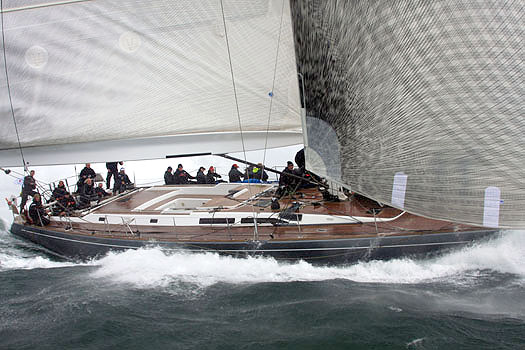
Mick Cotter's 77ft Whisper almost broke the 24-hour barrier for the record for the Dingle Race in the race of 2009. Photo: David O'Brien
Although the Irish Sea's champion J/109 Sgrech (Stephen Tudor) won't be involved, there are four of these useful all-rounders taking part, and Liam Shanahan's Ruth from the National YC was showing promising speed in the Scottish Series.
And a seriously interesting entry from further down the size scale is Paul O'Higgins' Corby 33 Rockabill V from Dun Laoghaire, which has an enviable racing record. The Corby 33 is more than sparse enough for most folk for a night or two at sea. Add in the increasing demands of the seaways as you get further west, and you have a challenging proposition which nevertheless could serve up a race win if conditions fall the right way. The smart money might just be on Rockabill V.

Paul O'Higgins' Corby 33 Rockabill V offers only the most austere comfort for offshore sailing, but in the right conditions her proven racing record might find itself augmented by the Dingle title.
National YC/Skellig Hotel Dun Laoghaire to Dingle Race 2013 Entry List
| Boat Name | Sail no | Model | Sun Division | Name | Surname | Club | IRC TCC |
|---|---|---|---|---|---|---|---|
| Antix | IRL 3939 | Ker 39 | Racing | Anthony / Peter | O'Leary | BSC/ RCYC | 1.136 |
| Joker II | IRL 1206 | J109 | Racing | John | Maybury | RIYC | 1.017 |
| Blue Eyes | IRL 9849 | Elan 340 | 2-handed | Colm | Buckley | HYC | 0.983 |
| Lisador | IRL 1295 | Dehler 36 | Racing | Henry | Hogg | Garrykennedy SC | 0.958 |
| Ruth | IRL 1383 | J109 | Racing | Liam | Shanahan | NYC | 1.02 |
| Jedi | IRL 8088 | J109 | Racing | Andrew | Sarrath | RIYC | 1018 |
| Spindrift | IRL 1503 | HR34 | Cruising | David | Kelly | Waterford SC | 0.938 |
| Polished Manx | GER8666 | Sigma 33 | Racing | Kuba | Szymanski | DBYC | 0.898 |
| Discover Ireland | IRL 7386 | Reflex 38 | Racing | Adhan | Fitzgerald | GBSC | 1.055 |
| Black jack | IRL 1988 | Pocock 38 | 2-handed | Peter/ Darren | Coad/Nicholson | WHSC | 0.934 |
| Conundrum | IRL 3503 | Hanse | Cruising | Michael | Pomeroy | RStGYC | 0.968 |
| Amazing Grace | IRL1966 | Oyster 37 | Racing | Brian | O'Sullivan | TBSC | 0.931 |
| Rockabill V | IRL 3307 | Corby 33 | Racing | Paul | O'Higgins | NYC/IRIYC | 1.041 |
| Aquelina | IRL 1281 | J-122 | Racing | James S | Tyrrell | ASC | 1.084 |
| Chancer | IRL 1583 | Elan 40 | Racing | Brian | Carroll | 1.027 | |
| White Tiger | IRL 4470 | Beneteau First 44.7 | Racing | Anthony | O'Brien | KYC | 1.113 |
| Mojito | GBR9047R | J109 | Racing | Peter | Dunlop | CHPwllheli SC | 1.014 |
| Ocean Tango | GBR6848T | Dehler34 | 2-Handed | Robert | Floate | DMYC/ WSC | 0.928 |
| Legally Blonde | IRL 3175 | Beneteau First 44.7 | Racing | Cathal/Paul | Drohan/Egan | RStGYC | 0.952 |
| Lulla Belle | IRL 3607 | Beneteau First 36.7 | 2-Handed | Liam/Brian | Coyne/Flahive | NYC | 1.001 |
| Wow | IRL 4208 | Farr42 | Racing | George | Sisk | RIYC | 1.144 |
| Adelie | IRL 9631 | Beneteau First 44.7 | Racing | Peter | Hall | NYC | 1.003 |
Comment on this story?
We'd like to hear from you! Leave a message in the box below or email William Nixon directly on [email protected]
WM Nixon's Saturday Sailing blog appears every Saturday on Afloat.ie
Follow us on twitter @afloatmagazine and on our Afloat facebook page
The Sailing Legacy of John Breslin Kearney
#irishmaritimehistory – It was a life which would have been remarkable by any standards, in any place, at any time. But in the Dublin of its era, this was a life of astonishing achievement against all the odds, in a rigidly structured society made even more conservative by a time of global unrest and national upheaval.
John Breslin Kearney (1879-1967) was born of a longshore family in the heart of Ringsend in Dublin, the eldest of four sons in a small house in Thorncastle Street. The crowded old houses backed onto the foreshore along the River Dodder in a relationship with the muddy inlet which was so intimate that at times of exceptional tidal surges, any ground floor rooms were at risk of flooding.
But at four of the houses, it enabled the back yards to be extended to become the boatyards of Foley, Murphy, Kearney and Smith. Other houses on Thorncastle Street provided space for riverside sail lofts, marine blacksmith workshops, traditional ropeworks, and all the other long-established specialist trades which served the needs of fishing boats, and the small vessels - rowed and sailed - with which the hobblers raced out into Dublin Bay and beyond to provide pilotage services for incoming ships. And increasingly, as Dublin acquired a growing middle class with the burgeoning wealth of the long Victorian era, the little boatyards along the Dodder also looked after the needs of the boats of the new breed of recreational summer sailors.
The young John Kearney was particularly interested in this aspect of activity at his father's boatyard, where he worked during time away from school. From an early age, he developed a natural ability as a boat and yacht designer, absorbing correspondence courses and testing his skills from 1897 onwards, when he designed and built his first 15ft sailing dinghy, aged just 18.
He was apprenticed in boat-building to Dublin Port & Docks across the river, qualifying as a master shipwright. But his talents were such that he rose to the top in all the areas of the port which required the designing and making of specialised structures, some of them very large. So in addition to building workboats of all sizes, he played a key role in projects like the new pile lighthouse at the North Bull, for which he developed support legs threaded like giant corkscrews, and rotated into the seabed like monster coachbolts.
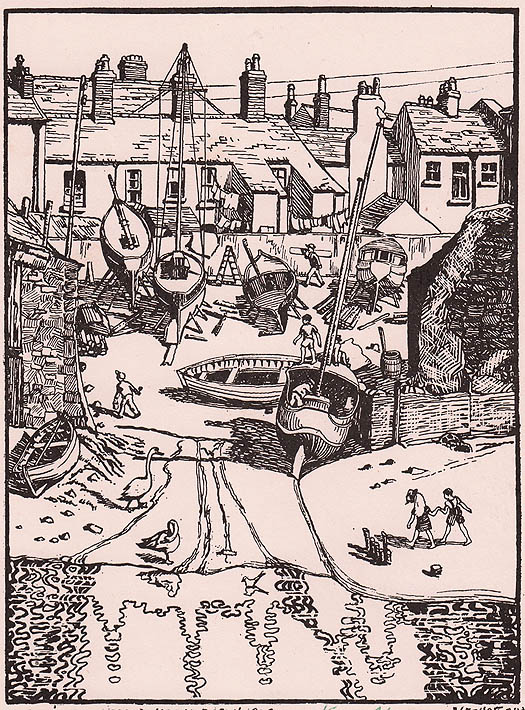
Murphy's Boatyard on the Dodder in Ringsend in the rare old times is perfectly captured in this woodcut by Harry Kernoff RHA. It was all disappeared in 1954, when the old houses of Thorncastle Street were replaced by a complex of Corporation flats of such good quality that they have recently had a major refurbishment.
He also pioneered the use of reinforced concrete for pre-fabricated harbour constructions, and when the Great War broke out in 1914, his special talents and experience were called upon to advise on quick-build ferrocement structures of all kinds. Although Ireland remained neutral as World War II broke out in 1939, the Dublin engineering firm of Smith and Pearson established a yard in Warrenpoint just across the border to build concrete barges and small ships for war work, and John Kearney was their consultant.
So far-reaching was his input into developing the infrastructure of Dublin port that when he retired in 1944, while his official title was as Superintendent of Construction Works, he was de facto the Harbour Engineer. But he couldn't be properly acknowledged as such, because he had never qualified from a third level college - it was far from universities that the Kearneys of Ringsend were reared.
However, this lack of an official title left him unfazed, for his retirement at the age of 65 meant he could concentrate full-time on his parallel career as a yacht designer, something that was so important to him that when his gravestone was erected in Glasnevin in 1967, it simply stated: John Kearney, Yacht Designer.
He had developed his skills in this area ever since his first boat in 1897. In 1901, when he was still 21, a 17ft clinker-built canoe yawl, the Satanella which Kearney designed and built for noted Dublin Bay sailor Pat Walsh, was praised in the London yachting press. Her owner camping-cruised this little boat successfully along the great rivers of Europe before World War 1, getting there simply by sailing his canoe from Dun Laoghaire into Dublin Docks, and striking a shipping deal with whichever ship's captain was heading for a port on the desired river.
Kearney had been busy for the ensuing nine years with his growing responsibilities in Dublin Port. But in 1910 he reserved a corner of Murphy's Yard, and in the next eighteen months, working in his spare time entirely by hand with the light of oil lamps, he built his first personal dreamship, the 36ft gaff yawl Ainmara, to his own design. In this his first proper yacht, he immediately achieved the Kearney hallmark of a handsome hull which looks good from any angle, a seakindly boat which was gentle with her crew yet had that priceless ability of the good cruising yacht – she could effortlessly maintain a respectable average speed over many miles while sailing the high seas in comfort.
Built in straightforward style of pitchpine planking on oak, Ainmara was highly regarded, and though the world was at war for four of the ten years John Kearney owned her, when he could sail his preferred cruising ground was Scotland. She was no slouch on the race course either. Her skipper became a member of Howth Sailing Club in 1920, and HSC's annual Lambay Race became a Kearney speciality, his first recorded overall win being in 1921 when, in a breezy race, Ainmara won the cruisers by one-and-a-half minutes.
Despite the turmoils of Ireland's War of Independence and Civil War, in the early 1920s John Kearney's position with the Port & Docks had become so secure that in 1923 he felt sufficiently confident to sell Ainmara in order to clear the way to build himself a new boat, the superb 38ft yawl Mavis, which was launched in July 1925. He was to own, cruise and race her with great success for nearly thirty years, by which time he was a pillar of the Dun Laoghaire sailing establishment – he'd a house in Monkstown, and had become Rear Commodore of the National Yacht Club, a position he held until his death in 1967.
Even with the demands of his work, and the continuing attention needed to run a yacht of the calibre of Mavis, he had found the time to design and sometimes also build other yachts of many types. What he didn't seem to have time for was simple domesticity. In later years his presence was enough to command respect, but in his vigorous younger days he could be waspish, to say the least, and a brief attempt at marriage was not a success.
Sibling relationships were also sometimes tense. Two of his brothers were boatbuilders and one of them, Jem, was almost always daggers-drawn with John. And Jem Kearney had regular battles with others, too. He was a classic Dublin character, and no stranger to salmon netting on the Liffey in circumstances of questionable legality. If one of these expeditions had been spectacularly successful, he would erupt triumphantly back into his family's little house on the East Wall Road and announce: "Pack you bags, Mrs Kearney, we're off to stay in the Gresham!" And he meant it, too. Mr & Mrs Jem Kearney of the East Wall Road became resident in the Gresham Hotel until the salmon money ran out.
So when he was building Mavis, John Kearney would only work with his brother Tom, and they were a fantastic team. But even that didn't last. One November night, working away at planking the hull, they took a break for a mug of tea at 9.30pm, and couldn't find the sugar. Each blamed the other for its absence. The row was seismic. The following night, each turned up with his own personal supply of tea, milk and sugar. And the work continued as smoothly as ever. But not one single word was exchanged between the two brothers for the remaining eight months of the project. It was years before they spoke again.
Quite what this meant when Mavis launched herself on St Stephens Day 1924 we can only guess. Like Ainmara eleven years earlier, Mavis could only be accommodated in Murphy's shed by being built in a large trench, and an exceptional Spring tide on December 26th 1924 saw her unplanned flotation. There was no damage done, but history doesn't record whether it was John and Tom who sorted the problem together despite not saying a word.
The immaculate Mavis made an immediate and successful impact, and Skipper Kearney and his beloved gaff yawl were honoured guests at regattas all along the east coast. While continuing to work full time for the Port & Docks, he kept up the spare-time yacht-building, but after the experiences with Mavis, when a regular Kearney crewmember, Billy Blood-Smyth, commissisoned a new 35ft gaff yawl from the skipper, it was client and designer who had to work together in the familiar corner of Murphy's yard to build the boat which became Sonia, launched in 1929.
Irish sailing was in a very quiet phase through the 1930s. Just about the only expanding organization was the Irish Cruising Club, and naturally John B Kearney and Mavis were on the first membership list in 1930, with Mavis a regular competitor in its offshore races, with a notable victory in the stormy 1935 race to the Isle of Man, a performance which won special praise from another participant, Humphrey Barton who was to found the Ocean Cruising Club 19 years later.
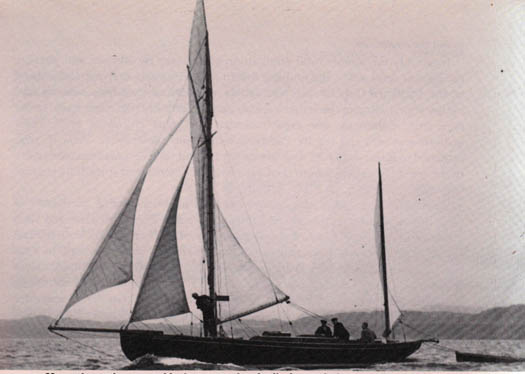
Mavis coming into port after winning the Clyde Cruising Club's annual Tobermory Race in 1938. Club rules at the time stipulated that as proper cruising yachts, the competing boats should tow their tenders throughout this race. Much effort went into designing sweet-lined dinghies.
Mavis also was overall winner of the Clyde Cruising Club's Tobermory Race in 1938. But while his own sailing was going splendidly, John Kearney was concerned at the sluggish state of sailing development in Ireland. In order to give younger people an opportunity to own their own boat, in 1932 he created the design for the 17ft Mermaid, a large clinker-built sailing dinghy which was designed to be constructed for around £180 - roughly the same price as a motorbike. The Mermaid was adopted by Dublin Bay SC, but it took a long time to gain momentum, and it wasn't until the late 1940s and early 1950s that it became the most popular class in the greater Dublin area. It is still active today with nearly 200 boats built, and more than 40 took part in its 80th Anniversary championship last summer in Skerries, the winner being Jonathan O'Rourke from the National YC,while the furthest travelled was Patrick Boardman's Thumbalina from Rush, which had started from Foynes on the Shannon Estuary, home to the most distant Mermaid fleet, and had – most impressively - sailed all the way round the south coast to Skerries to mark the 80th birthday.

The Mermaid was designed in 1932 to be built at the same price as the average motor-bike
With his retirement in 1944, John Kearney's design work came centre stage, and he was busy to the end, creating more than 20 cruising yachts in all. And life in Monkstown was pleasant. Over the door of the room where he did his design work, he'd a little motto on a brass plate: "God gives us our relatives. Thank God we can choose our friends". His close friends were all from sailing, and it was a crew member who had joined Mavis in 1946, the formidable Miss Douglas, who became his friend and housekeeper and looked after him to the end of his long and remarkable life.

John Kearney, aged 83, working at the drawings of his last design, the 54ft yawl Helen of Howth Photo: Tom Hudson

Sonia, built 1929, cruising in British Columbia, her home waters since 1958 Photo: Jeff Graham
John Kearney's entire life is in its way a great legacy, and his fine boats are his tangible memorials. They've ventured to the far corners of the world. For instance, the 30ft Evora, a lovely Bermudan yawl which he designed for building by Skinner's of Baltimore in 1936, was last reported from Darwin in Australia. The pretty Sonia of 1929 is well at home these days in British Columbia. And as for Mavis, the crème de la crème, she is currently undergoing a painstaking restoration in Maine by shipwright Ron Hawkins, who is very encouraged by the amount of original material he is able to retain.
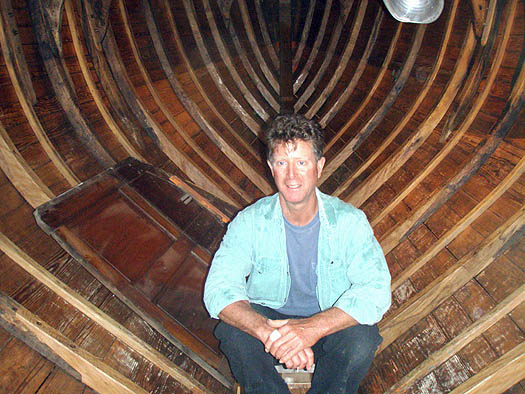
Ron Hawkins in Mavis at an early stage of his restoration project Photo: Hal Sisk

Ron Hawkins has been much encouraged by the amount of original material he has been able to retain in restoring Mavis Photo: Denise Pukas
John Kearney's first proper yacht, the 9-tonner Ainmara from 1912, has been owned for 47 years by former Round Ireland record holder Dickie Gomes of Strangford Lough. Last year, she celebrated her Centenary with a cruise to the Outer Hebrides. This year - next week in fact - she hopes to be in Dublin Bay for the Old Gaffers Association Golden Jubilee. And as it will be at Poolbeg Yacht & Boat Club, Ainmara will be back home in Ringsend for the first time in 90 years, and John Breslin Kearney will be well remembered, and celebrated too.
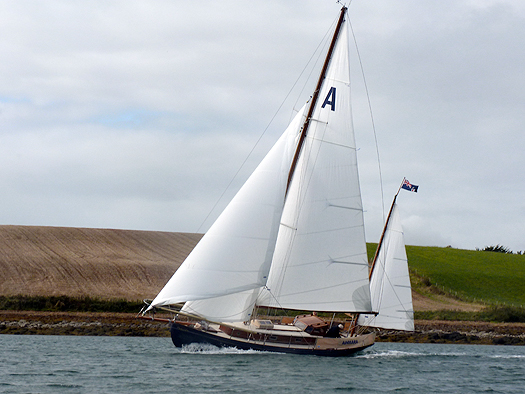
Still going strong. Dickie Gomes is the happy owner aboard Ainmara, which will be returning to Ringsend next week 101 years after she was built there to his own designs by John B Kearney Photo: W M Nixon
Comment on this story?
We'd like to hear from you! Leave a message in the box below or email William Nixon directly on [email protected]
WM Nixon's Saturday Sailing blog appears every Saturday on Afloat.ie
Follow us on twitter @afloatmagazine and on our Afloat facebook page
#FF – An initiative to introduce more sailors to one of Dublin Bay's most popular one design keelboats has been boosted with news of a fleet sponsor for the double-handed Flying fifteen (FF) class.
Kia Motors Ireland are on board with the Dublin fleet that is based almost exclusively at the National Yacht Club on Dun Laoghaire's East Pier.
The fleet currently has 20 plus boats for local DBSC racing with at least double that number for regional championships. The class plans a number of local initiatives to encourage sailors from other classes to try out the FF during midweek racing. Local sailing instructors are also being targeted as possible new recruits.
The class recently published its 2013 fixtures with two events in Northern Ireland – another FF stronghold – but the season finale is in Dun Laoghaire in the autumn and there are big plans to gather as many crews as possible for the October 5th event under the Kia motors banner.
Dun Laoghaire's National Yacht Club has a small pontoon facility with limited berthing for visiting yachts. The facility also has diesel, water, power and overnight facilities are available to cruising yachtsmen with shopping facilities being a short walk away
The club's pontoon is primarily used by its members for the short term securing of dry sailec boats prior to and after racing.
Boats dry-sailing from the platform and Club launches/RiB's have priority on the inside pontoons.
There is also a marked area for launches onto which no other vessel should berth.
Fuelling alongside may be arranged at non-racing times.
Boats may not remain overnight without the approval of the Club Boatman, unless arriving after service hours. The rate for berths are available from the club directly.
Glenans Sailing School Launch 2013 Season in Dun Laoghaire
#glenans – Minister for Transport, Tourism and Sport Leo Varadkar launched Glenans 2013 season this afternoon at the National Yacht Club in Dun Laoghaire.
As Europe's largest sailing school the French club has bases in Baltimore in West Cork and on Collanmore Island on Clew bay in County Mayo.
The Minister helped the school to launch its annual Irish sales brochure.
The Irish Glenans operation was established in 1969 and was reintegrated into its French parent in 2011.
Olympic Race Officer Jack Roy To Give Talk at Howth YC
#HYC - Next week Howth Yacht Club will host international race officer Jack Roy of the National Yacht Club, who will give an illustrated talk on his experiences in Weymouth at the London Olympics last summer.
Roy was selected by the ISAF as a technical officer, one of only seven race officers selected to supervise the UK race management teams at the Olympics.
He was also the only one of the seven who rotated through all the courses, and his talk gives a fascinating insight on how the Olympic regatta was managed.
Roy's talk takes place at the HYC on Wednesday 13 March at 8pm, and will last about 75 mins with time for questions afterwards. Admission is free, but a voluntary donation to the RNLI is expected (€5 suggested).



























